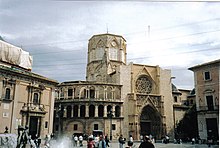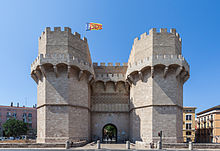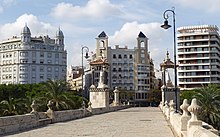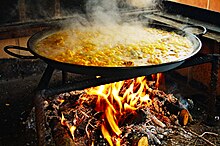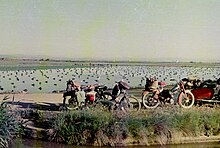Valencia
| Valencia | ||
|---|---|---|
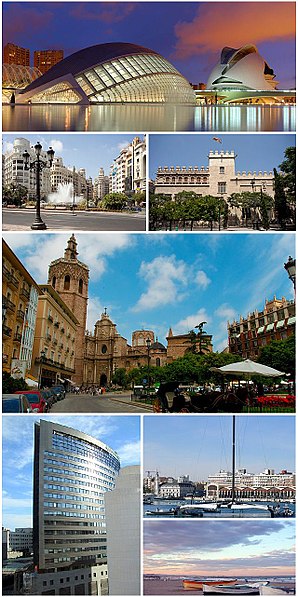 panorama
|
||
| coat of arms | Map of Spain | |

|
|
|
| Basic data | ||
| Autonomous Community : | Valencia | |
| Province : | Valencia | |
| Comarca : | Valencia | |
| Coordinates | 39 ° 29 ′ N , 0 ° 22 ′ W | |
| Height : | 15 msnm | |
| Area : | 134.65 km² | |
| Residents : | 794,288 (Jan 1, 2019) | |
| Population density : | 5,898.91 inhabitants / km² | |
| Founding: | Romans ; 138 BC Chr. | |
| Postal code : | 46000-46099 | |
| Municipality number ( INE ): | 46250 | |
| Nearest airport : | Valencia-Manises Airport | |
| administration | ||
| Official language : | Castilian , Valencian | |
| Mayor : | Joan Ribó ( Compromis ) | |
| Website : | www.valencia.es | |
Valencia ( German [vaˈlɛn (t) si̯a]; Spanish [ baˈlenθja ]; Valencian / Catalan : València [ vaˈɫensia ], German outdated: Valentz ) is a city in the eastern part of Spain . The capital of the autonomous Valencian Community and the province of Valencia is located around 320 km southeast of the state capital Madrid at the confluence of the Turia into the Mediterranean and with 794,288 (as of January 1, 2019) inhabitants is the third largest city in the country after Madrid and Barcelona . Around two million people live in the greater Valencia area.
Valencia is the seat of the Roman Catholic Archdiocese of Valencia , which dates back to the 6th century, but was re-established after the end of Moorish rule. The episcopal church is the Cathedral of Valencia , whose patronage is celebrated on the Assumption of Mary .
geography
Valencia is located on the Spanish Mediterranean coast , about 350 km southwest of Barcelona at the mouth of the Turia River and almost exactly at the same latitude as Mallorca . The Turia River was moved out of the city after devastating floods in the 1950s (last time in 1957); the former river bed has been converted into a park. The city has three beaches (Playa de las Arenas, Playa de Malvarrosa and Playa de la Patacona).
climate
Valencia has a pronounced Mediterranean climate . The annual average temperature is 18.3 ° C and fluctuates between 11.8 ° C in January and 26.1 ° C in August. The daytime temperatures in January are an average of 16.4 ° C. In winter, temperatures almost never drop below 4–8 ° C, and during the day it can be 18–25 ° C. In summer up to 40 ° C is possible, while temperatures drop to 20-25 ° C at night.
The annual rainfall is a little less than 475 mm. It rains mostly in spring and autumn, about five days a month. The first week of October is "famous" for its heavy rainfall. The summer months of June, July and August are almost free of rain.
The mean water temperature in Valencia is over 22 ° C from June to October, and it reaches its maximum in August at 27 ° C. In the winter months the mean water temperature is 14–16 ° C.
| Valencia | ||||||||||||||||||||||||||||||||||||||||||||||||
|---|---|---|---|---|---|---|---|---|---|---|---|---|---|---|---|---|---|---|---|---|---|---|---|---|---|---|---|---|---|---|---|---|---|---|---|---|---|---|---|---|---|---|---|---|---|---|---|---|
| Climate diagram | ||||||||||||||||||||||||||||||||||||||||||||||||
| ||||||||||||||||||||||||||||||||||||||||||||||||
|
Average monthly temperatures and rainfall for València
Source: AEMET 1981-2010,
|
|||||||||||||||||||||||||||||||||||||||||||||||||||||||||||||||||||||||||||||||||||||||||||||||||||||||||||||||||||||||||||||||||||||||||||||||||||||||||||||||||||||||||||||||||||||||||||||||||||
structure
Some of today's districts used to be independent settlements or villages that were annexed to the city of Valencia mainly in the second half of the 19th century, including Beniferri, Benimaclet , Patraix and Russafa around 1877; Benimàmet and Orriols around 1887; Borbotó, Campanar, Mauella, Pueblo Nuevo del Mar and Villanueva del Grao around 1897; and Benifaraig, Carpesa and Masarrojos around 1900.
| Ciutat Vella | La Seu - La Xerea - El Carme - El Pilar - El Mercat - Sant Francesc |
|---|---|
| Eixample | Russafa - El Pla Del Remei - Gran Via |
| Extra murs | El Botànic - La Roqueta - La Petxina - Arrancapins |
| Campanar | Campanar - Tendetes - El Calvari - Sant Pau |
| La Saïdia | Marxalenes - Morvedre - Trinity - Tormos - Sant Antoni |
| El Pla del Reial | Exposició - Mestalla - Rei Jaume - Ciutat Universitària |
| Olivereta | Nou Moles - Soternes - Tres Forques - La Fontsanta - La Llum |
| Patraix | Patraix - Sant Isidre - Vara De Quart - Safranar - Favara |
| Jesus | La Raiosa - L'Hort De Senabre - La Creu Coberta - Sant Marcel lí - Cami Reial |
| Quatre Carreres | Montolivet - La Font d'En Corts - Malilla - La Fonteta de Sant Lluís - Na Rovella - La Punta - Ciutat de les Arts i les Ciències |
| Poblats Marítims | El Grau - El Cabanyal-El Canyamelar - La Malva-rosa - Beteró - Natzaret |
| Camins al Grau | Aiora - Albors - La Creu Del Grau - Camí Fondo - Penya-Roja |
| Algirós | L'Illa Perduda - Ciutat Jardí - L'Amistat - La Vega Baixa - La Carrasca |
| Benimaclet | Benimaclet - Camí de Vera |
| Rascanya | Orriols - Torrefiel - Sant Llorenç |
| Benicalap | Benicalap - Ciutat Fallera |
| Poblats del Nord | Benifaraig - Poble Nou - Carpesa - Cases de Bàrcena - Mauella - Masarrojos - Borbotó |
|---|---|
| Poblats de l'Oest | Benimàmet - Beniferri |
| Poblats del Sud | Forn d'Alcedo - Castellar-L'Oliveral - Pinedo - El Saler - El Palmar - El Perellonet - La Torre - Faitanar |
history
Antiquity
138 BC According to the historian Titus Livius , the city of Valentia [ wa'lentia ] was founded by the Roman consul Decimus Junius Brutus Callaicus . About a hundred years later, Valentia became one of the first Hispanic cities to become a Roman colony . The Roman settlement was where the core of the old town around the cathedral is today, about four kilometers from the sea on a river island in the Turia .
middle Ages
Hardly developed under Visigothic rule, the city made rapid progress after the Arab conquest in 711 and reached 15,000 inhabitants in the Caliphate of Córdoba .
During the time of the Taifa kingdoms , the Amirids and the Dhun Nunids ruled in "Balansiya" . In the 11th century, the Amirids had a new city wall built, which is the first, the exact course of which is still known today.
In 1094 El Cid , a Castilian nobleman, conquered the city. The conquest did not take place on behalf of one of the Christian kingdoms of the peninsula, but on the account of the Cid, who proclaimed himself "Lord of Valencia" (Señor de Valencia) and thus created a kind of private kingdom. He was able to defend the city against several attacks by the Almoravids and after his death in 1099 his widow Jimena also managed to hold Valencia until 1102.
In 1102, Valencia fell to the Almoravids, a little later - like the entire Islamic area of rule on the peninsula - to the Almohads . After the victory of the united Christian armies over the Almohads in the battle of Las Navas de Tolosa (1212), Moorish Spain split up again into individual small kingdoms, including another Taifa of Valencia.
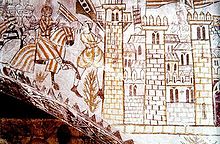
It was finally conquered in 1238 by King James I of Aragon , who entered the city on October 9th (now known as the Día de la Comunidad Valenciana regional holiday) of the year after a five-month siege . He made the former Taifa the Kingdom of Valencia part of the Crown of Aragon .
In the middle of the 14th century a new city wall was built, which tripled the protected area to 142 hectares compared to the previous Moorish building.
In the 15th century the city experienced rapid growth and developed into one of the largest Mediterranean ports and an important trading and financial center. A main branch of the economy was silk weaving. At the beginning of the 15th century the city had around 40,000 inhabitants, but in 1483 around 75,000 people were already living in the city. During this time, numerous Gothic city palaces and also the Lonja de la Seda ("Silk Exchange") were built. Joanot Martorell , author of Tirant lo Blanch and the poet Ausiàs March are famous Valencians from this period.
The first printing press on the Iberian Peninsula was also in Valencia. In 1478 the first Bible was printed in a Romance language (Valencian). This is attributed to Bonifaci Ferrer . With artists from the Italian rulers of the Crown of Aragón, the new art epoch of the Renaissance also showed its first manifestations on the Iberian Peninsula in Valencia.
Modern times
Valencia had no share in trade with the New World, which until the 18th century was carried out exclusively via the Andalusian ports of Seville and Cádiz . In 1520 - at the same time as the Comuneros uprising against King Charles I (the German Emperor Charles V) in Toledo and other cities - there was a rebellion in Valencia of the guilds that were united in brotherhoods (Germaníes) . After the royal cavalry triumphed over the rebellious Comuneros at Villalar in April 1521, the Germanías uprising was also suppressed.
The expulsion of the Moriscos , who made up a large part of the working population, especially in the countryside, from the lands of the Crown of Aragón in 1609 plunged the Kingdom of Valencia and its capital into a deep economic crisis from which they emerged in the course of the century only slowly recovered.
During the War of the Spanish Succession from 1701 to 1714, Valencia sided with Charles of Austria . After the victory of the Bourbons in the Battle of Almansa on April 25, 1707, the city and Kingdom of Valencia lost their privileges when the new Philip V dissolved the old structures and created a centralized monarchy.
During the Napoleonic Wars , the French could not get the city under their control for a long time. After it became known in Valencia on May 23, 1808 that Charles IV and his son Ferdinand VII had renounced the Spanish crown in Bayonne under pressure from Napoleon in favor of his brother Joseph Bonaparte , a defensive structure was formed under pressure from the population. Junta, which was able to repel a first attack by French troops in June 1808. Another siege by Napoleonic troops in March 1810 also failed. It was not until January 1812 that Marshal Suchet succeeded in conquering Valencia, which was then occupied by French troops until July 1813.
In the second half of the 19th century, the city walls, which increasingly narrowed the city in its further development, were torn down, and new districts with wide, checkered streets were built in the west and south (today's districts of Eixample and Extramurs). In the old town, after the demolition of medieval houses, the two large plazas, Plaza del Ayuntamiento and Plaza de la Reina, were created.
In the first decades of the 20th century, the Valencian architecture - like that of Barcelona - was under the sign of modernism , which is still evident today in the facades of numerous bourgeois residential buildings, the Estación del Norte train station and the market halls Mercat Central and Mercat de Colón shows. During the Spanish Civil War 1936-1939, Valencia belonged to the area controlled by the Republicans and from November 1936 was the seat of government of the republic instead of Madrid , which was located directly in the combat zone ; in November 1937, however, the Republican government moved its seat to Barcelona . The city suffered greatly from the bombing of the Franco air force and finally fell on March 30, 1939 as one of the last cities in their hands.
A catastrophic flood of the Turia in 1957 , in which human lives were to be mourned and which also caused considerable material damage, was of great importance for the further development of the city. The Spanish state and the city of Valencia decided on the Sur plan , which envisaged draining the river bed and leading the river in a wide arc south of the city. The corresponding hydraulic engineering work was completed in the 1970s. The original plan was to build an urban motorway in the drained river bed , but this was later abandoned for cost reasons and due to popular resistance. Rather, it should be turned into the Jardín del Turia , a large park. The Catalan architect Ricardo Bofill was commissioned with the basic planning in 1981. With the implementation of the project, one of the previously greenest cities in Spain received a “green lung” with parks, sports and leisure facilities running through the entire urban area.
In addition, further urban development measures have been implemented in the last few decades, which have made Valencia increasingly attractive as a tourist destination. These include a (not yet completed) renovation of the old town and the construction of modern event and museum buildings such as the Palau de la Música (1987), the Institut Valencià d'Art Modern (IVAM, 1989) and the Congress Palace ( Norman Foster , 1998) . For the America's Cup , which was held in Valencia in 2007 and 2010, the modern Marina Real Juan Carlos I was built in the old harbor basin . In the lower part of the former river bed of the Turia, the Ciudad de las Artes y de las Ciencias was built from 1991 to 2006 , for whose monumental, postmodern buildings the star architect Santiago Calatrava , born in a suburb of Valencia, is responsible. In 2008, the Formula 1 circuit was Valencia Street Circuit created, there is a partially in the street circuit is, who is also the harbor of Marina Real surrounds.
The military coup of February 23, 1981 , as a counter-reaction to the democratization after the end of the Franco dictatorship , the commander of the III. Military Region, General Jaime Milans del Bosch , by u. a. Crashed tanks on the streets of Valencia. In the early morning of February 24th he ordered them back to the barracks after realizing that the coup attempt would fail because no other garrisons except Madrid and Valencia had actively participated. Milans del Bosch was later tried and sentenced to nearly 27 years in prison, of which he served nine years.
The Ruta Destroy
In the 1980s and early 1990s , Valencia became the party capital of Spain with the street Ruta Destroy , also known as Ruta del Bakalao . Well-known nightclubs in the 1980s were Barraca, Spook Factory, Chocolate, Espiral, NOD, Puzzle and ACTV; Heaven, Villa Adelina, Zona and Templo were added later. In addition to U2, the music genres EBM , synth pop , house and gothic rock were played. The current bands from Germany, Great Britain and other Western European countries were popular. Local groups such as Megabeat , Amnesia, Athualpua, Antico, Hypnosis, Nova also formed, which, despite their comparable quality, were mostly only known in Spain. Cetu Javu from Germany with a Spanish singer was also one of the bands known at the time. On the Ruta Destroy, the action took place not only in the clubs, but also outdoors at car parties. The party mile attracted up to 30,000 younger people on the weekends, who came from all over Spain. The parties were also known for erotic permissiveness and drug use.
They were therefore rejected by conservative politicians and the media. These also linked the Alcácer crime (the kidnapping, rape, torture and murder of three 14 to 15 year old girls in a suburb of Valencia in 1992) to the party scene.
In the later 1990s the popularity of the Ruta Destroy declined, as did the musical quality of the music groups, mostly only primitive techno variants were played. A number of discotheques still exist today.
The battle for El Cabanyal
Valencia is the scene of one of the longest conflicts in the field of conflict between urban renewal and the preservation of historic buildings. In order to build a large boulevard of the city, the Avenida de Blasco Ibáñez, to the sea, the city government appointed by the Partido Popular decided in 1997 on a plan that calls for the demolition of large parts of the former fishing village of El Cabanyal . Since these years an initiative of residents, monument protectionists and artists from all over the world has been fighting against the destruction of the unique ensemble of Modernismo , located directly on the sea. While the city government has repeatedly been able to demolish individual houses during these years, the “Salvem el Cabanyal” initiative tried to defend itself through demonstrations and - ultimately unsuccessful - lawsuits up to the highest court. Since most of the affected houses are listed, the Ministry of Culture, which was dominated by the Socialists at the time, finally intervened in Madrid in 2010 to prevent the “looting” of this cultural asset worthy of protection. As a result of the real estate crisis in Spain from 2009 onwards, such a large real estate and urban redevelopment project would be difficult to implement anyway. The left city government elected in 2015 has stopped the project.
politics
Results of the municipal council election 2015:
- PP : 10 seats
- Compromís : 9 seats
- Ciudadanos : 6 seats
- PSOE : 5 seats
- Podemos : 3 seats
Mayor is Joan Ribó ( Coalició Compromís ).
In the May 2015 election, the Partido Popular suffered considerable losses.
Culture and sights
Torres de Serranos
The former city gate Torres de Serranos is the most famous landmark of Valencia. It formed the entrance to the city from the north-west, i.e. on the highways from Barcelona and Zaragoza, and was inserted into the city wall, which is no longer in existence today. Immediately in front of the gate, the Turia river had to be crossed on a 100 meter long bridge. The building was erected between 1392 and 1398. The towers are a good 30 meters high. The rear wall was removed in the 19th century so that the building is now open from the rear. At times it served as a prison. The gate is the only remaining city gate next to the similarly imposing “Torres de Quart”.
Lonja de la Seda
The silk exchange ( Spanish: Lonja de la Seda ; val. Llotja de la Seda ) was built between 1482 and 1533 under the direction of the master stonemason Pere Compte and is considered one of the most important buildings of the secular Gothic in Europe. It consists of four parts: the tower, the Consulado del Mar room, the orange tree courtyard and the pillared room. The entire complex with built and undeveloped zones is over 2000 m². Since 7 December 1996, the Lonja belongs to the UNESCO - World Heritage Site .
Valencia Cathedral
The Cathedral of Valencia was on the foundations of an old from 1262 mosque built. Until the end of the 18th century, the building was redesigned many times. The Puerta de los Apóstoles, from the 14th century, the Puerta del Palau, the oldest portal of the cathedral, Romanesque with influences from the Mudéjar , and the Puerta Barroca are striking. The 14th century Gothic tower, Torre del Miguelete, attached to the cathedral is one of the city's landmarks.
In a side chapel of the cathedral, an agate chalice is kept as a relic , which is traditionally venerated as the Holy Chalice or Holy Grail and is linked in literature with the legend of the Holy Grail. Experts date the mortar-shaped stone cup to the 1st century BC.
The oldest water court in Europe (Spanish Tribunal de las Aguas ) meets in front of the apostle portal of the cathedral every Thursday , a unique public procedure in which disputes among the farmers of the surrounding area ( Huerta ) about the irrigation of the fields are settled.
Ciutat de les Arts i les Ciències
The City of Arts and Sciences was designed by the Valencian architect Santiago Calatrava . It is located in the former river bed of the Turia and includes the following sights (ranked according to the opening date):
- L'Hemisfèric - IMAX cinema, constructed as an eye that opens and closes
- Museo de las Ciencias Príncipe Felipe - Natural Science Museum
- L'Umbracle - Botanical Garden and Discotheque
- L'Oceanogràfic - Europe 's largest aquarium
- Palau de les Arts Reina Sofía - opera house and music palace with four halls and around 40,000 m² total area
- El Puente de l'Assut de l'Or - a cable-stayed bridge, the 125 meter high pillar of which forms the highest point in the city
- L'Àgora - closed event space in which u. a. Concerts, exhibitions and sporting events take place
Museums, zoos, botanical gardens and parks
- Museu de Prehistòria de València Museum of the early history of Valencia
- Museu Valencià d'Etnologia Valencian Museum of Ethnology
- Casa Museo Blasco Ibáñez
- Casa Museo Concha Piquer
- Casa Museo José Benlliure
- Casa Museo Semana Santa Marinera
- Galeria del Tossal
- Institut Valencià d'Art Modern (IVAM) - Centro Julio González Center Julio González - Valencian Institute of Modern Art
- Museo Casa de las Rocas
- Museo del Arroz Rice Museum
- Museo de Bellas Artes Museum of Fine Arts
- Museo de Ciencias Naturales Natural Science Museum
- Museo de Informática Computer Science Museum
- Museo de la Asociación Valenciana de Arte y Tecnología Eléctrica - ARTTEL
- Museo de la Catedral Museum of the cathedral
- Museo de la Ciudad Municipal Museum
- Museo del Colegio Arte Mayor de la Seda
- Museo del Gremio de Artistas falleros Museum of the Committee of the Fallas Artists
- Museo del Juguete Toy Museum
- Museo del Patriarca Museum of the Patriarch
- Museo del Siglo XIX Museum of the 19th century
- Museo Fallero Fallas Museum
- Museo de Historia de la Medicina Museum of the History of Medicine
- Museo de Historia de Valencia Museum of the History of Valencia
- Museo Histórico Militar Museum of military history
- Museo Histórico Municipal
- Sala de Exposiciones del Museo Histórico Municipal
- Museo Marítimo Joaquín Saludes Maritime Museum Joaquín Saludes
- Museo Municipal de Ciencias Naturales
- Museo Municipal del Trenet
- Museo Nacional de Cerámica “González Martí” González Martí National Museum of Ceramics
- Museo Taurino de Valencia - Bullfighting Museum
- Museo Valenciano de Historia Natural Valencian Museum of Natural History
- MUVIM - Museo Valenciano de la Ilustración y la Modernidad Valencian Museum of Illustration and Modernism
- Botanical Garden
- Zoological Garden
- City park in the old river bed of the Turia
- Bioparc adventure zoo
Classic and historical bridges
There are a number of classic-looking bridges in Valencia , including some historic bridge structures:
- Puente Real, from the 16th century, is used as a traffic bridge with 10 fields
- Puente del Mar, built in 1591, pedestrian bridge less than 10 m wide, but with 10 arches an impressive 160 m long
- Puente del Regne, one of the younger bridges and, at 220 m, also the longest of the city's classic bridges
- Puente del Àngel Custodio, a young girder bridge from 1933 with a length of 150 m
- Puente San José, founded in the 14th century as a wooden bridge, replaced by a stone bridge in the 17th century
- Puente de Serranos a Valencia, built in 1518 in the early 16th century
- Puente de la Trinidad, this bridge was built at the beginning of the 15th century with Gothic style elements on the site of a former Moorish wooden bridge
Sports
Sport is very important in Valencia and has always been generously supported despite financial difficulties on the part of the city and the country. The pleasant climate and the long coastline make the city the ideal place for water sports, such as B. sailing, surfing or water skiing. The cityscape itself is characterized by sporting facilities, to be mentioned are the numerous opportunities for sporting activities along the drained river bed of the Turia, the venerable Mestalla football stadium in the middle of the city, and the boxes of the sailing teams at the port. The America's Cup , the world's most famous and prestigious sailing regatta, took place there in 2007 and 2010 . From 2008 to 2012, the European Grand Prix took place every year, also along the newly created Formula 1 track at the port, the Valencia Street Circuit . The Valencia Grand Prix , which is part of the Motorcycle World Championship , has been held at the Ricardo Tormo Circuit in Cheste since 1999 . Sporadic races of the German Tour Car Masters are held there.
The most famous football club in the city of Valencia CF has already achieved great success, the team has already won the highest Spanish league, Primera División , six times , most recently in the 2003/2004 season, in which it also won the UEFA Cup and Supercup. The last major success was in the 2007/2008 season, when the Copa del Rey was won for the seventh time . The club had to struggle with serious financial problems during the economic crisis, which delayed the opening of the new Nou Mestalla stadium again and again. The team's training center is located in Paterna , where the games for the amateur, women's and youth teams are also played. With UD Levante , the city has a second football club in the Primera División, which plays its games in the Estadio Ciudad de Valencia and qualified for the UEFA Europa League in the 2011/2012 season .
Valencia is currently the only city in Spain with two teams in the National American Football League (LNFA). The Valencia Firebats and the Valencia Giants share the Estadio Municipal Jardín del Turia . The Firebats are three-time champions of the Spanish league and have represented Spain in the European football playoffs since 2005.
The Valencia Basket Club (formerly Pamesa Valencia) plays in the Spanish ACB league and plays the games in the Pabellón Fuente de San Luis . The stadium is also home to the women's team Ros Casares Valencia , which is the Spanish record champions in women's basketball with eight titles and won the Euroleague Women in 2012.
The Club de Tenis Valencia has been organizing an international tennis tournament since 1995 , which was included in the ATP World Tour 500 in 2009 and takes place in the Ciudad de las Artes y Ciencias. It is there that the International Open Valencia, which is part of the World Padel Tour , will be held. From 2009 to 2011 the Global Champions Tour in show jumping was held here .
Every year in autumn, a triathlon, a marathon and a half marathon are held in Valencia with thousands of participants. Numerous fun runs (Volta a Peu) take place throughout the year.
Valencia is also a respected meeting place for national and international golfers. All year round you can play on four different golf courses in the vicinity, Campo de Golf El Saler , El Bosque Club de Golf , Real Club de Golf Manises and the Club de Golf Escorpión .
Events
The city is known for the annual Fallas ( Spanish [ ˈfaʎas ]) or Falles ( Valencian / Catalan [ ˈfajes ]). The Fallas are celebrations of the districts in honor of Joseph , the patron saint of carpenters . The Falleros y Falleras, organized in the nearly 400 Comisiones Falleras in the individual districts , produce up to 30 meters tall figures out of wood, paper mache and styrofoam, the “fallas” . The fallas caricature z. B. outstanding events from social and political life in a mostly satirical way.
The Fallas start at the beginning of March and reach on 15. – 19. March culminates. They are celebrated with parades through the districts in traditional costume, banquets and fireworks. There are two different categories of fireworks: one is the mascletàs that take place every day at 2 p.m. in all Fallas; by far the largest is the Mascletá organized by the city on Plaça de l'Ajuntament . The other are the Castillos de fuegos artificiales which are shot into the night sky on the four nights before March 19th. The most important and most impressive is the nit del foc (span. Noche del fuego / night of fire ) on the night of March 18th to 19th. On March 17th and 18th, the Virgen de los Desamparados will be offered flowers with parades (ofrenda) . The flowers are put together in front of the basilica on the Plaça de la Virgen to form a 10 meter high image of the Virgin. On the night of March 19-20, the fallas figures are burned in an act called cremà .
Two film festivals are held annually in Valencia : one is the Mostra de Valencía - Cinema del Mediterrani , where films from Mediterranean countries have been shown in an international competition since 1980 , and the other is the Festival Internacional de Cine Cinema Jove , which has been presenting films by new directors since 1985 dedicates.
In July 2006 the Catholic World Family Meeting with the then Pope Benedict XVI took place in Valencia . with up to two million participants.
Culinary specialties
The Valencian cuisine is characterized by rice , meat , fish and local vegetables . The best-known Valencian dish is the rice dish paella , which is traditionally prepared in a special flat pan (the so-called "paellera") over an open fire (or on a special gas stove). The rice variety (Bomba) comes from the cultivation area on the edge of the lake within the La Albufera Natural Park south of Valencia, which also offers a unique biodiversity of birds and insects.
The traditional variant is the Paella Valenciana with chicken , rabbit , giant beans and green beans. There are also other variations, e.g. B. Paella marinera with fish and seafood, or Paella de verduras with vegetables. Although the Spanish cuisine is very regional, the paella in Spain is very well known, so that different paella variations can be found in the different regions of Spain . Other regional rice dishes are Arroz al Horno "rice from the oven" or Arroz a Banda or Arroz negro . The pasta variant of paella (with fish and seafood) is called fideuà .
Another typical feature of Valencia is the horchata , a drink made from tiger nuts that are grown in the north of Valencia, near Alboraya. Fartóns are eaten with the horchata . Just as typical are Cebada , a malt drink that has survived from Roman times, Agua de Valencia , a mixed drink made from Spanish sparkling wine ( Cava ), orange brandy and freshly squeezed orange juice, and Mistela de moscatel , a liqueur wine made from Muscatel .
Leche merengada , a type of sorbet based on milk and meringue (“merengue”), flavored with lemon peel and cinnamon , is popular in summer . A scoop of Leche Merengada ice cream (optionally also nata ( cream ice cream )) on coffee sorbet is called "Blanco y Negro". With a scoop of mantecado ( vanilla -cream ice cream) it becomes the national typical of Valencia .
Orange fields line the streets of the Valencia area. Valencia was and still is a center for citrus fruits .
economy
A large employer is the nearby Cofrentes nuclear power plant and the Ford car plant in Almussafes 20 km south of the city. The latter has produced over nine million automobiles since it was founded in 1976. The Kuga , Mondeo , Connect and SMAX models are currently in production. The Ford plant directly employs 7,000 people and provides 21,000 additional indirect jobs in supplier companies. In addition, rice etc. is also produced in the region. the like.
tourism
The Costa de Valencia is the coastal region of the province of Valencia. Traditionally, this stretch of coast, like the province of Castellón, belongs to the Costa del Azahar . In the course of the tourist development of Valencia, however, the tourist name Costa de Valencia has become naturalized for the coastal region of Valencia, which is now one of the most important holiday destinations in Spain. The Costa de Valencia is also a popular destination for language and city trips.
education
In Valencia there are a total of over 80,000 students at the two universities, University of Valencia and Polytechnic University of Valencia . A German school has been located here since 1961 .
The school system in Valencia is also affected by a rigorous austerity policy by the over-indebted state, which had to save around 40 billion euros in 2012. In February 2012, students protested against the resulting grievances. a. had been taught for weeks in unheated rooms. The demonstration was put down by police forces.
Transport and logistics
Valencia can be reached from the air via Manises Airport, eight kilometers from the city center , which is often served by scheduled flights from Germany via Mallorca . From there there is a metro and bus connection into the city. Occasionally, however, it can be cheaper to travel to the neighboring airports in Alicante in the south or Barcelona in the north.
The port city is connected by rail to Alicante , Barcelona and Madrid in the long-distance network (Grandes Líneas) of the Spanish state railway Renfe . Renfe operates an S-Bahn network around Valencia ( Cercanías Valencia , Valencian Rodalia ) with six lines with, however, very different service quality, which all start and end in this terminus at València Nord due to the cramped conditions :
- C1: Gandia , some train pairs to and from Platia i Grau de Gandia
- C2: Xàtiva and Moixent
- C3: Buñol , Utiel
- C4: Quart de Poblet
- C5: Sagunto and Teruel
- C6: Sagunto and Castellón de la Plana
The routes to Moixent, Utiel, Teruel and Castellón are also served by regional trains going beyond the endpoints of the S-Bahn service.
The North Station (Estación del Norte) is located in the city center. 800 meters to the south is the Joaquin Sorolla station , which was built as the provisional end point of the high-speed line Madrid – Levante . In the medium term, both are to be combined into a rail transport hub.
In 1988 the first section of the Valencia Metro was inaugurated. The network emerged from the existing, meter-gauge suburban railway network that the FGV had previously taken over from the FEVE . Due to the competitive situation of the original companies, it took until 1998 for the first transfer option (València Nord / Xàtiva) to be set up between the Renfe S-Bahn and Metro networks.
In road traffic, Valencia is connected to Madrid in a westerly direction via the E-901 , which is also a feeder to the AP-7 , an important north-south axis along the coast towards Barcelona. The A-23 Sagunt –Somport (Pyrenees Pass), which connects Valencia with Teruel and Saragossa , is currently under construction .
port
Valencia has a major seaport with container terminals , vehicle handling (around 800,000 units in 2017), ferry connections and rail connections. In the port of Valencia 2008, a cargo volume of 59.1 million tons was handled, an increase of 11.48% over the previous year. It is the second largest container port in Spain and one of the most important in the Mediterranean. In 2019, 5.44 million TEU were handled.
In 2008, 199,335 passengers were recorded in regular ferry services with the Balearic Islands and Italy. The total volume including cruise ships was 474,814 passengers. In 2019, the port of Valencia handled 1.028 million passengers, 592,205 in ferry traffic and 435,616 in cruise ship traffic.
Local public transport
The city of Valencia has a very dense bus network of over 60 lines operated by the transport company EMT Valencia , which characterizes the cityscape. This has been supplemented by nine metro and tram lines since 1988 , which have been expanded significantly in recent years. Some metro lines connect surrounding places with the city center. Other localities are reached by various bus transport companies that merged into a transport association (MetroBus) at the end of the 1990s .
Travelers usually use the inexpensive 10-trip tickets (bonobus), but there are also day and month tickets.
Patron saint
Saint Vincent Ferrer , who was also born here, is the patron saint of the city ( city patron ).
Twin cities
-
 Mainz ( Rhineland-Palatinate )
Mainz ( Rhineland-Palatinate ) -
 Bologna ( Italy )
Bologna ( Italy ) -
 Vera Cruz ( Mexico )
Vera Cruz ( Mexico ) -
 Valencia ( Venezuela )
Valencia ( Venezuela ) -
 Sacramento ( USA )
Sacramento ( USA ) -
 Odessa ( Ukraine )
Odessa ( Ukraine ) -
 Rize ( Turkey )
Rize ( Turkey )
sons and daughters of the town
Famous people from Valencia include King Peter III. , the composers Vicente Martín y Soler , Joaquin Rodrigo , José Serrano, Ruperto Chapi, the painters Joan de Joanes, José de Ribera, Joaquín Sorolla , the artist Mariano Benlliure, the writers Juan Luis Vives , Ausiàs March , Vicente Blasco Ibáñez , the singers Camilo Sesto, Nino Bravo, Concha Piquer, Bruno Lomas, the architect Santiago Calatrava , and the soccer players Juanfran and Raúl Albiol .
Web links
Individual evidence
- ↑ Cifras oficiales de población resultantes de la revisión del Padrón municipal a 1 de enero . Population statistics from the Instituto Nacional de Estadística (population update).
- ^ Joan Ribó será alcalde de Valencia , El Mundo , June 5, 2015
- ↑ Standard climate values. València AEMET, accessed July 10, 2018.
- ↑ www.rutadestroy.com
- ↑ Archived copy ( memento of the original from January 19, 2012 in the Internet Archive ) Info: The archive link was inserted automatically and has not yet been checked. Please check the original and archive link according to the instructions and then remove this notice.
- ↑ La eterna batalla de El Cabanyal, El Mundo, January 17, 2011, accessed February 2, 2012
- ↑ Urban planning "Let's save El Cabanyal!", FAZ from October 1, 2010
- ↑ TORRES DE SERRANOS (SERRANOS TOWERS). Retrieved November 24, 2019 .
- ↑ a fertile, artificially irrigated plain in Spain, from Latin hortus for garden.
- ↑ Levante-EMC: Valencia - Levante-EMC - Hemeroteca 28-02-2008. In: www.levante-emv.com. Retrieved January 3, 2017 .
- ↑ See e.g. B. Ute Müller: Spanish police beat minors . In: WELT Online from February 21, 2012.
- ↑ Valencia plans further growth . In: Daily port report of 23 August 2017, p. 13
- ↑ Benjamin Klare: Piraeus new number 1 . In: Daily port report , May 27, 2020, p. 13
- ↑ Port administration on valenciaport.com (Spanish)
- ↑ Statistical Report Port Authority of Valencia 2019 Valenciaport, accessed July 29, 2020




